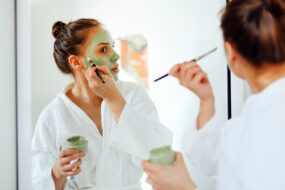Why a skin purge may be the secret to a healthy, glowing complexion
Starting a new skin care program can often lead to breakouts, or a ‘skin purge’, but experts insist that’s not always such a bad thing.
Have you ever started a new active skincare product, only to break out weeks later?
There is a chance you have experienced a skin purge.
Dermatologist Dr Eleni Yiasemides says skin purging refers to temporary breakouts or acne flare-ups that sometimes occur after you start using certain active skincare ingredients.
- Silky smooth: How dermablading can help you get glowing skin
Common culprits behind a skin purge
Cosmetic chemist and author Terri Vinson identifies the main instigators as certain forms of vitamin A, including retinoic acid and retinol, along with chemical exfoliating acids such as AHAs — lactic and glycolic acid — and BHA salicylic acid.
“These active ingredients all make the skin work harder to create new cells that restore and regenerate the skin surface,” Terri explains.
This rapidly increased skin cell turnover also causes any pre-existing oil, sebum and keratin in the follicles to appear on the face, faster, she says.
Dermal therapist Gabrielle Singh from GC Skin Boutique says this usually takes the form of whiteheads, blackheads, pustules and possibly cysts, along with dryness and soft flakiness.
“This is often misinterpreted as a bad reaction to the product, but it’s actually a sign that the active ingredient is working and the skin is regenerating,” Gabrielle says.
The experts confirm a purge phase lasts about a month, equivalent to the average skin regeneration cycle.
Should you try to purge your skin?
So why would you want to put your face through it?
“Skin purging is a short-term rite of passage as the skin acclimatises to these new effective active ingredients,” Terri says.
“Once your skin is used to them, it’s going to make positive changes to the complexion in the long run.”
- Diet rules: How to eat your way to healthier skin
How to safely regenerate your skin
Despite the recent popularity of skin purging, Gabrielle suggests a “slow and steady” introduction of active skincare to reduce the likelihood of a purge.
“While it’s great to want to take the fast route, if you go in too quick and aggressively with an active product, it can actually create new problems,” Gabrielle says.
For instance, if you’re a first-time retinoid user, Dr Yiasemides suggests easing into the product by starting with twice-weekly applications for a couple of weeks, then slowly increasing to three times a week and then eventually every night.
“Use no more than a thin smear and cut back if you experience any kind of redness, burning or peeling,” she says.
For some people, even a “go slow” approach can set off a reaction.
“For these people, it’s worth going through a few weeks of purging in order to achieve clearer skin,” Dr Yiasemides, of SouthDerm clinic, says.
- Skin microbiome: How rewilding can work wonders
Signs of irritated skin
It’s one thing to be prepared for a skin purge after introducing an active ingredient — but don’t mistake it for skin that’s downright irritated.
Dr Yiasemides says large areas of redness, itchiness, burning or excessive peeling are signs of a possible allergic or irritant reaction.
“An irritation reaction occurs all over the face after you’ve applied the product, whereas a purge only occurs in areas you’d normally break out,” she says.
- Easy care: The 8 commandments for healthy skin
Stick with the (skin) program
When your skin is in purge mode, it can be tempting to stop using the product that caused it.
But the experts say to persist.
“The key is to keep going because it has to get worse before it can get better,” Terri says.
Dr Yiasemides says results may only be visible in the weeks after a purge cycle has ended.
“Once the skin clears, it will reveal a clearer and more luminous complexion,” she says.
Written by Sharon Hunt.




